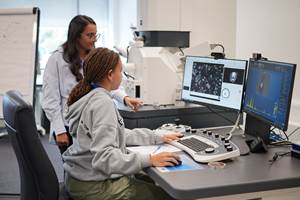Planning application submitted for National Manufacturing Institute Scotland
The NMIS will be an industry-led international center of manufacturing expertise led by Scottish leaders and the University of Strathclyde.

Source | University of Strathclyde Glasgow
A planning application has been submitted for the development of the National Manufacturing Institute Scotland (NMIS) situated at the center of the Advanced Manufacturing Innovation District Scotland (AMIDS) in Renfrewshire.
NMIS will be a £65 million, industry-led international center of manufacturing expertise led by the Scottish government in partnership with the University of Strathclyde and Renfrewshire Council. Operated by Strathclyde, as a national facility for Scotland, the goal of NMIS is to be a place where research, industry and the public sector work together to transform skills, productivity and innovation to attract investment and make Scotland a global leader in advanced manufacturing.
The new, energy carbon neutral, facility next to Glasgow Airport will include a skills academy, a fully digitalized factory of the future and a collaboration hub for manufacturers to work together with research partners and the public sector to innovate and grow their businesses.
NMIS also includes two specialist technology centers: the Lightweight Manufacturing Centre (LMC), which was opened earlier this year by the First Minister; and Strathclyde’s Advanced Forming Research Centre, which is the only High Value Manufacturing Catapult center in Scotland. Iain Bomphray, previous of Williams Advanced Engineering, is now director of the LMC.
The application for NMIS will now be considered by Renfrewshire Council.
NMIS and the Medicines Manufacturing Innovation Centre, in which Strathclyde is lead research partner, will be the anchor institutions in the advanced manufacturing district. The district is benefiting from a £39 million investment to provide the enabling infrastructure, funded through the Glasgow City Region City Deal. It is also home to the NMIS specialist technology centers.
Glasgow-based HLM Architects is leading the NMIS design team, which also includes Waterman Civil & Structural Engineers, Davie + McCulloch Building Services Engineers and Robinson Low Francis LLP Cost Mangers. HLM will also be providing landscape architecture and interior design services, while Turner and Townsend have been appointed as Project Managers under Strathclyde’s Framework Agreement.
“Manufacturing is crucial to our economy and is a sector we want to see flourish in Scotland. This is a notable milestone for the NMIS facility and given the importance of responding to the global climate emergency, I am particularly pleased the facility will be energy carbon neutral and it is great that the facility will lead by example and demonstrate what is possible,” says Economy Secretary Derek Mackay. “NMIS will deliver benefits for businesses across Scotland well before the building is complete including through the existing capability available at the Lightweight Manufacturing Centre which adds to the wider support available from our enterprise agencies to help companies improve their productivity.”
“Scotland has a vibrant manufacturing sector which is well placed for further innovation and growth. To achieve its fullest potential, it needs advanced facilities, resources and equipment, for use by highly qualified and skilled staff; NMIS will offer all of this. At Strathclyde, we have the drive, expertise and track record to support this highly collaborative venture and, with the NMIS partners, support the transformation of Scottish manufacturing,” says Professor Sir Jim McDonald, Strathclyde’s principal.
Related Content
Reducing accidental separator inclusion in prepreg layup
ST Engineering MRAS discusses the importance of addressing human factors to reduce separator inclusion in bonded structures.
Read MoreNASA names university teams for aeronautics research challenges
As part of the agency’s University Leadership Initiative, three multidisciplinary teams will address topics related to growth in AAM, while a fourth examines electricity generation for future airliners.
Read MoreNew online training course targets prepreg basics
JEC World 2024: Composites Expert highlights how its E-Learning Composites Academy platform supports flexible industry learning with new courses developed with Stelia Aerospace North America.
Read MoreZeiss, Imperial College London summer school enhances materials, sustainability learning
Twenty-four next-generation students attended the Imperial College London this August to advance their scientific knowledge, with workshops, lectures, activities and a composites competition.
Read MoreRead Next
All-recycled, needle-punched nonwoven CFRP slashes carbon footprint of Formula 2 seat
Dallara and Tenowo collaborate to produce a race-ready Formula 2 seat using recycled carbon fiber, reducing CO2 emissions by 97.5% compared to virgin materials.
Read MoreVIDEO: High-volume processing for fiberglass components
Cannon Ergos, a company specializing in high-ton presses and equipment for composites fabrication and plastics processing, displayed automotive and industrial components at CAMX 2024.
Read More“Structured air” TPS safeguards composite structures
Powered by an 85% air/15% pure polyimide aerogel, Blueshift’s novel material system protects structures during transient thermal events from -200°C to beyond 2400°C for rockets, battery boxes and more.
Read More
.jpg;width=70;height=70;mode=crop)














.jpg;maxWidth=300;quality=90)









